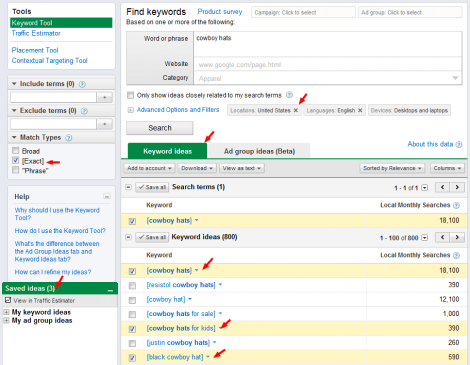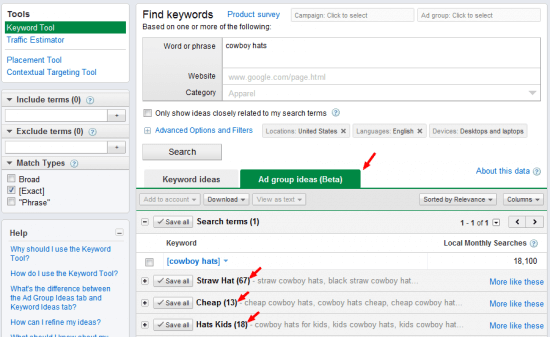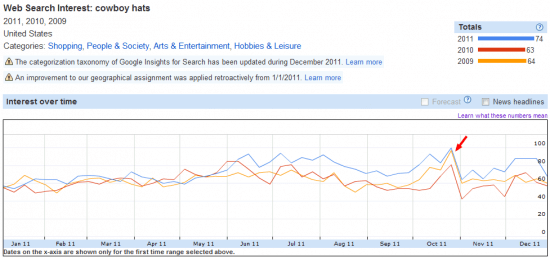Why would we define a keyword research process? Because there are many ways to do it and it can go on forever. I like to think of keyword research as a never-ending marathon and it’s probably best to prepare yourself than to show up on the day of the race all stiff. There is a long road ahead and establishing a keyword research process is the first step that will help get you where you want to go more effectively and efficiently.
Step 1: Brainstorm
There are 4 steps to an effectively keyword research process, and the first is brainstorming of keywords. Let’s remember who we are optimizing for: the user. With that in mind, let’s ask:
- How would a customer search for you?
- What services do you offer?
- Is there more than one way of saying an industry term? (policy/industry vs. customer)
I’d like to think back to the 5W’s (who, what, where, when and why) and ask the questions from a customer stand point about the company. On a basic level, answers to these questions should be laid out on the site. But as you move along, write it all down!
Some more ways to explode that keyword list
Wikipedia
I’ve always found Wikipedia to be a great source in the keyword brainstorming process given that it is a collective effort to maintain fresh and relevant content that is available for everyone. If we take the topic of “welding” for example, we know that there is a large list of different welding services that the industry offers. But as SEOs, we don’t know much about the industry to start off, so we turn to the web to learn about it. If we go to the welding page on Wikipedia we see that welding has other terms that closely associate with it like fabrication and laser cutting. If we scroll further down, we start to discover other content on Wikipedia to be helpful, like the list of welding codes that detail out the different types of welding that you can do as a business or individual. Gold!
Thesaurus
The Thesaurus is great for helping you come up with a list of action keywords. If you’re in the business of providing support, then you’re going to use keywords like “support” or “help”. While these may be your primary action keywords, there might be others out there that you may not have considered. Use the Thesaurus to gather more thoughts on how some people could be searching for you.
Google Suggest
This one is self-explanatory, but one that might be overlooked because it’s a norm now that we get suggestions on things in search, and we never actually finish typing the entire query.
Go to Google and begin typing “recipes for chicken” and you’ll get suggestions like,
- Recipes for chicken breast
- Recipes for chicken thighs
- Recipes for chicken drumsticks
- Recipes for chicken wings
All of this is making me hungry…
You can also use the xPathBuilder, if you are more advanced with Google Docs and the Import XML function, to pull suggested keywords from Google into a spreadsheet. Here’s a post by Tom that explains more of what xPathBuilder is – an Introduction to xPatherBuilder.com.
Google Keyword Tool
I’ve seen the Google keyword tool evolve over the years and more and more it is becoming a good suggestion source for additional keyword ideas. Pop over to the Google Keyword Tool, type in a query and obtain a list of suggested keywords for that phrase. Later I go into the details of the tool, so hold on tight for now.
Competitor Websites
“Keep your friends close, and your enemies closer”. We’re not all enemies of one another, but let’s face it, for a business to succeed and sustain itself, it needs competitors.
Search for your key services, analyze the top 5 competitors and study their content structure. Does your site have those areas covered? Are categories are they using? Are you using the same keywords? Is there search volume to back up the talk? This is why doing research is so critical!
By the end of all this brainstorming, you should have a solid understanding of the industry, the products and services, as well as the competitors in the space. If you don’t, I recommend going back and taking more notes!
If you want more suggestions on what Keyword Tool to use, check out this list of Favourite Keyword Tools by Richard Baxter.
2. Draw your weapons keyword tools and collect data
In the wild wild west, we would be drawing guns and looking for opportunities to duel. But here, we’re resolving optimization issues and we’re telling that story with data. We have a common saying here at Cardinal Path, that data speaks the truth, and we’re here to uncover that truth. So off we go to the races.
Mine the data
Most people like to see number; at least I do, so let’s bring some figures into the spreadsheet with the initial keywords that we got from step 1. I like to use the Google Keyword Tool for this task, simply because it is easy to use and it has a wealth of data that we could mine from.
I’d like to configure this tool by setting the following:
- Exact match – this will return search volume for the keyword exactly as it is [keyword].
- Locations – I work with Canadian and US clients, so specifying the correct location is important.
Let’s walk through a quick example here. If we were interested in selling cowboy hats, we may want to know the search demand (search volume) for this product. [cowboy hats] returns 18,100 searches per month, on average in the last 12 months. To keep things simple, we will only look at US search volume, but you can look at global if you wanted to.

Select the keywords you want to keep, export it to CSV and pull all the data into a single spreadsheet.
Keyword Categorization
Let’s stop comparing Beetles and Lamborghini’s.
When we define “categorization”, it is the process of grouping similar and like-elements for a specific purpose. Categorizing keywords means just that; grouping related keywords and differentiating them from a pool of keywords. My example earlier about Beatles and Lamborghini’s, they can’t be compared side-by-side because they are in different classes. So let’s keep this in mind when we’re gather the data and begin to analyze it.
We want to group keywords into categories because we want to identify relative demand in different areas of the subject we are researching. For example, is there higher demand for “cheap cowboy hats” vs. “straw cowboy hats”?
Because there are many different combinations that could be searched, you’re not capturing the full demand figure in just one keyword. For example, if we looked at straw cowboy hats, we see that people are also searching for:
- Straw cowboy hats 1,600
- Straw cowboy hat 720
- Cowboy straw hats 110
- Black straw cowboy hats 170
- Mens straw cowboy hats 110
That’s 1,100 more searches if we hadn’t considered other combinations and long-tail terms!
So, collect as much data as you can, work with the data offline, select which ones to optimize for and measure the performance of the keyword groups over time. In the next post, I will talk in greater detail about keyword categorization and drawing insights from the analytics keyword data. There is a lot buried in the rubble and it’s a matter of digging it up and making sense of it.
Here’s a great article by Richard Baxter on Using Categories to Make Your Process More Actionable if you want to learn more on using Excel functions to categorize keywords (advanced techniques).
Uh, who thought about this brilliant idea? A New Feature in the Google Keyword Tool!
This is a new feature that was rolled out just last week, and I think it provides some great insight into keyword categorization. It is called Ad Group Ideas, currently in beta. By default, this option is turned on. This means that you will get to the Ad group ideas tab first before the Keyword Ideas.
Google is making it easier for advertisers to create ad groups with related and similar keyword phrases. What can we SEOs draw from this? Keyword Categories!
I suggest expanding some of these keyword categories and having a closer look at how these keywords are grouped. For example, we see that some of the popular cowboy hats are Straw Cowboy Hats, Cheap Cowboy Hats and Cowboy Hats for Kids. If you export data out of this tab, you’ll get an additional column called “Ad Group”, which you can use as your keyword categories column. Isn’t that slick?
Here’s a look at the new feature:

Have you made use of this feature yet? Share your thoughts about this in the comments below.
3. Consider Keyword Search Trends
Ever wonder why people are not commenting on your Facebook status update at 2AM in the morning? Search works the same way; some things get searched more at specific times of the year. So let’s stop wasting time and schedule releases more appropriately.
Because keyword tools only provide average searches for the last 12 months of the year, it does not account for seasonality trends. So what do we do about this? We turn to another tool to get deeper insights on search patterns for keywords. My favourite tool is the Google Insights for Search tool.
For example, if we use the cowboy hats example, we can look back at the last three years and identify if there are any noticeable trends in search for this keyword.
“cowboy hats” appear to be a bit more popular this year in the US and most search activity happen later in the year, late October showing a sharp peak every year. Why is that?

Not only do we know how it trends over time, but we can now take this insight and add it to our editorial calendars to ensure we are pushing content out in a timely and planned manner.
4. Piecing it all Together
As we emphasized in this post, we could spend hours, days, weeks, or even months doing
keyword research and collect a mountain of data. Keyword research provides great insight into consumer demand and trends that we can take action on. But in order to see results from all of this, we need to move the needle and put it all into action!
Your next steps are obvious; create a content strategy and begin optimizing. Whether you are a small, medium or an enterprise business, establishing a content strategy will define whether your campaign executes successfully. What does a content strategy entail?
- Market research – look at market demand for your products / services and the demographics who would be interested in it. This is to ensure you understand your audience.
- Define what type of content to create – content assets can range from blog posts, user generated content (UGC), PDFs, video, Infographics, and the list goes on. This is the part where we figure out what type of content is best consumed by your customers, to make their purchasing decision seamless and easy to action.
- Create an editorial calendar – plan ahead and determine when you are going to do a marketing push. This relies on the market research to tell you what those search terms are and when search is high and when it is stale.
- Create personas – to understand the customer better, we need to paint a picture about their purchasing behaviour. This requires pulling in many sources of data to create personas around your customers (i.e. customer database, web analytics data, search demand data, etc.)
- Resourcing and costs – how much time will it take to write, format and publish one blog post? How much time will it take on a weekly / monthly basis? How much will it cost to create an Infographic? These are ultimately the questions that go through a decision maker’s mind when they want to pursue any of the things you recommend. Be prepared for the worst and estimate how much resourcing will be required.
There you have it. I hope by now you see the complexity of keyword research and why it is important to streamline some of this work by first establishing a process. Keyword research itself is not effective if you don’t put it to work. Draw actionable recommendations, take those actions, and measure results.
Does your company have a standard keyword research process? Is it different than the one I shared with you here? I’d like to hear from you, please leave a comment in the box below.












